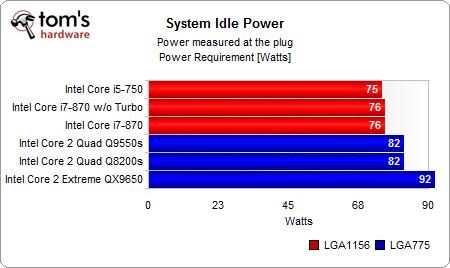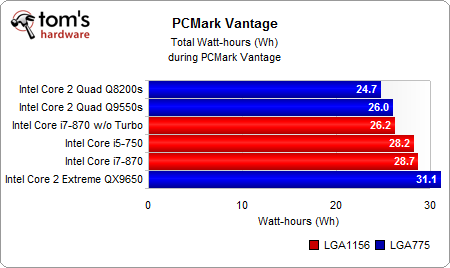Does Turbo Boost Help Or Hurt Core i5/i7's Power Efficiency?
Power Consumption
Clearly, the new Core i5/i7 processor generation on LGA 1156 requires considerably less idle power than Core 2 Quad. In this example, we even used the S-models (low-power) of Intel’s Core 2 Quad family, which are more efficient at idle and particularly at peak power. However, for comparison at the other end of the spectrum, we also tested the Core 2 Extreme QX9650, the most power-hungry model in its family. On our test system, using a GeForce GTX260², the LGA 1156 platform requires between 6W and 16W less idle power than the Core 2 family.
At peak power using Prime95, the two Core 2 Quad S-models remain the most efficient products. However, keep in mind that they were designed for efficiency (Ed.: and priced accordingly; that Q9550S is still a $219 part). They’re rated at a 65W TDP, while the new LGA 1156 processors are 95W models. The Core 2 Extreme QX9650 processor is a juice-guzzling 130W CPU.
Peak power of these processors directly corresponds to maximum clock speed. If we enable Turbo Boost on the Core i7-870, the processor can reach up to 3.6 GHz. As a result, peak power consumption will also be very close to the thermal envelope’s top edge in an effort to maximize performance. Disabling Turbo Boost in the Core i7-870 results in an obvious decrease of peak power from 182W to 178W. The Core i5-750 keeps its maximum clock speed much lower: 3.2 GHz in Turbo Boost mode or 2.8 GHz with four active cores.
Next, we tracked the total power used (in watt-hours) by the test systems to complete one full PCMark Vantage run. In our Core i5/i7 launch article, you could see that the new CPUs outperform Core 2 Quad models. The power-efficient S-models require less power for this workload, but they take more time to complete the benchmark. Intel’s old Core 2 Extreme QX9650 is the most voracious processor here. The LGA 1156 chips aren’t particularly low on power consumption, but keep in mind that Turbo Boost provides an extra performance kick. Let’s turn to performance per watt now.
Get Tom's Hardware's best news and in-depth reviews, straight to your inbox.


